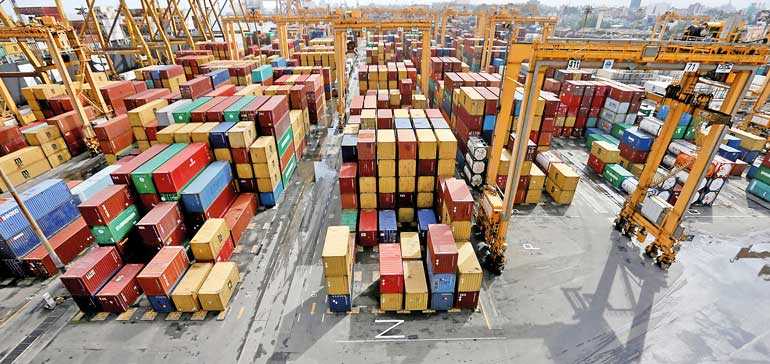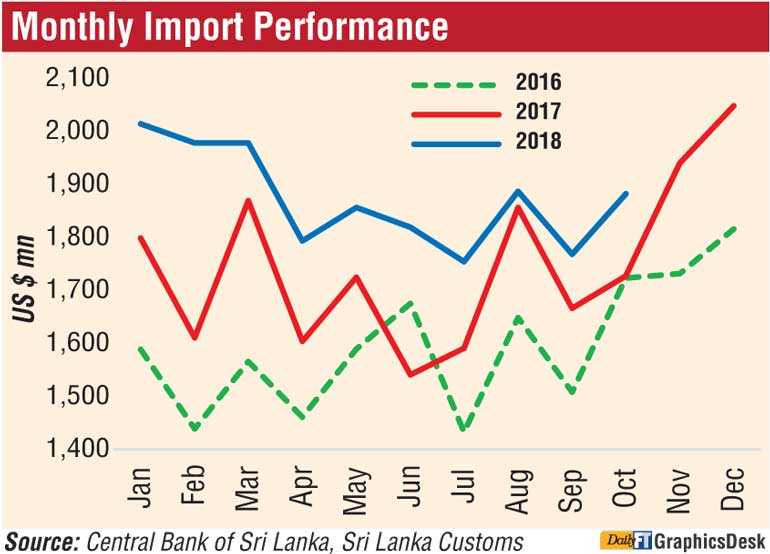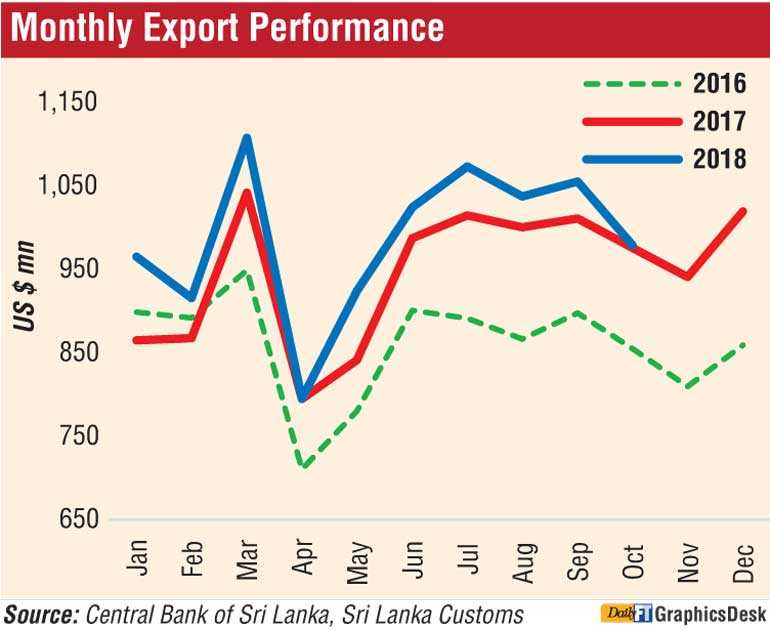Saturday Apr 19, 2025
Saturday Apr 19, 2025
Monday, 24 December 2018 01:08 - - {{hitsCtrl.values.hits}}

Exports up by mere 0.4% to $ 979 m; imports swell by 9% to $ 1.88 b, widening trade deficit to $ 903 m
Year-to-date exports up 5% to $9.87 b; imports by 10.3% to $ 18.7 b, and trade deficit balloons to $ 8.8 b
The country’s external sector came under severe pressure in October as exports struggled and imports jumped, widening the trade deficit further.
The higher growth in imports was despite measures by the Central Bank in September and October to curtail waste of foreign exchange on non-essential goods.
Exports managed to grow by only 0.4% to $ 979 million in October and failed to repeat the crossing of $ 1 billion mark, a feat achieved four times between January and September.

Imports in October rose by 9% to $ 1.88 billion, the highest since August.
The twin developments saw trade deficit widen by $ 903 million, as against $ 752 million a year earlier.
Year-to-date, exports have grown by 5.1% to $ 9.87 billion, and imports by 10.3% to $ 18.73 billion, expanding the trade deficit to $ 8.85 billion, up from $ 7.6 billion in the first 10 months of last year.
“Sri Lanka’s external sector continued to be under pressure in October,” the Central Bank said. However, it expects the trend of increasing imports will reduce in the coming months with the lagged impact of recently introduced restrictions on certain import categories.
Central Bank said the marginal growth of exports in October reflects mainly the decline in agricultural exports by 11.5%, which offset the 4.5% growth of industrial exports.
Under industrial exports, export earnings from textiles and garments increased marginally in October due to higher earnings from textile exports despite the slight decline registered in garment exports. The reduced earnings from garment exports was mainly driven by the lower demand from the USA, despite an increase in exports to the EU market and non-traditional markets, such as India, Canada, Japan and Hong Kong. Further, reflecting the combined impact of both volume and export prices, earnings from petroleum products increased significantly in October.
Export earnings from food, beverages, tobacco, base metals and articles increased substantially during October due to improved performance in most of their sub-categories. In addition, export earnings from animal fodder, machinery and mechanical appliances, and transport equipment rose in October, contributing towards the increase in industrial exports. However, export earnings from rubber products, gems, diamonds and jewellery, leather, travel goods, and footwear declined in October.
Earnings from agricultural exports were lower during the month owing to the poor performance in almost all sub-categories, except seafood, vegetables and rubber. Reflecting lower average export prices and exported volumes, export earnings from tea declined in October.
Export earnings from spices also reduced during the month due to the poor performance in most categories of spices. Further, despite an increase in earnings from coconut non-kernel products, earnings from coconut exports decreased due to the drop in earnings from coconut kernel products, such as desiccated coconut and coconut oil. However, owing to higher exports to the EU market, earnings from seafood exports rose during the month.
Leading markets for merchandise exports of Sri Lanka in October were the USA, India, the UK, Italy and Germany, which accounted for about 50% of total exports.
In terms of imports all three sub-categories–intermediate, consumer, and investment goods – contributed to the growth.
Expenditure on intermediate goods rose due to higher imports of textiles and textile articles – led by fabric and yarn, fuel and wheat and maize imports. Expenditure on fuel imports rose with higher import prices of both crude oil and refined petroleum products despite the reduction recorded in import volume of refined petroleum.
In addition, import expenditure on wheat and maize, chemical products, fertiliser, rubber and articles thereof, and plastic and articles thereof increased in October.
However, import of gold declined significantly, reflecting the impact of customs duty imposed since April.
Import of consumer goods rose, owing to higher imports of personal motor cars less than 1,500 CC, hybrid and electric motor vehicles.
“However, it is expected that the importation of motor vehicles would decelerate in the coming months, reflecting the lagged impact on such imports of the policy measures introduced in September,” the Central Bank said.

Expenditure on rice imports declined, indicating the availability of sufficient quantities of domestic supply. Import of categories such as clothing and accessories, telecommunication devices, household and furniture items, and home appliances, too, declined, partly reflecting the impact of restrictions on non-essential consumer goods imports while also responding to relatively larger depreciation.
Imports expenditure on investment goods rose mainly due to higher expenditure incurred on machinery and equipment, and building material imports. However, import of transport equipment reduced due to lower imports of commercial vehicles, such as tankers and bowsers, lorries, buses, and commercial cabs.
China, India, Singapore, Japan and UAE were the main import origins in October, accounting for 61% of total imports.
Discover Kapruka, the leading online shopping platform in Sri Lanka, where you can conveniently send Gifts and Flowers to your loved ones for any event including Valentine ’s Day. Explore a wide range of popular Shopping Categories on Kapruka, including Toys, Groceries, Electronics, Birthday Cakes, Fruits, Chocolates, Flower Bouquets, Clothing, Watches, Lingerie, Gift Sets and Jewellery. Also if you’re interested in selling with Kapruka, Partner Central by Kapruka is the best solution to start with. Moreover, through Kapruka Global Shop, you can also enjoy the convenience of purchasing products from renowned platforms like Amazon and eBay and have them delivered to Sri Lanka.
Discover Kapruka, the leading online shopping platform in Sri Lanka, where you can conveniently send Gifts and Flowers to your loved ones for any event including Valentine ’s Day. Explore a wide range of popular Shopping Categories on Kapruka, including Toys, Groceries, Electronics, Birthday Cakes, Fruits, Chocolates, Flower Bouquets, Clothing, Watches, Lingerie, Gift Sets and Jewellery. Also if you’re interested in selling with Kapruka, Partner Central by Kapruka is the best solution to start with. Moreover, through Kapruka Global Shop, you can also enjoy the convenience of purchasing products from renowned platforms like Amazon and eBay and have them delivered to Sri Lanka.